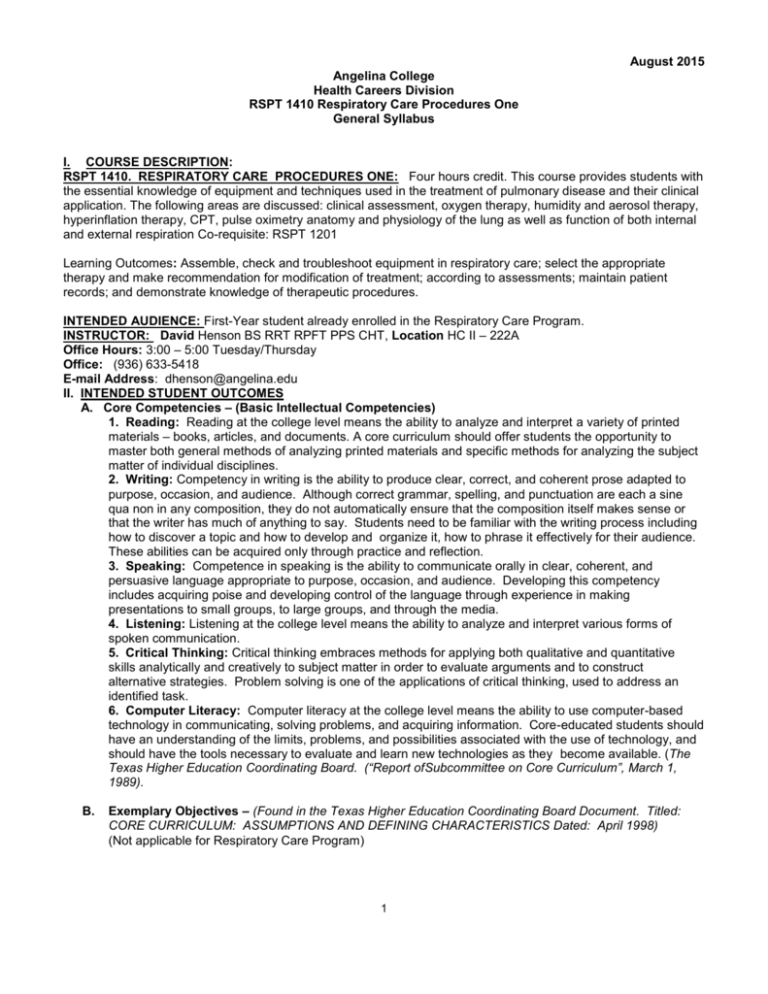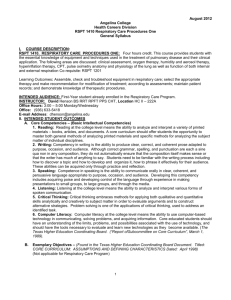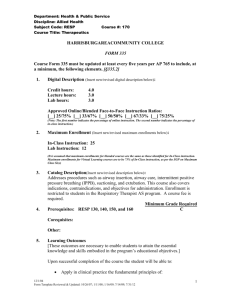Syllabus
advertisement

August 2015 Angelina College Health Careers Division RSPT 1410 Respiratory Care Procedures One General Syllabus I. COURSE DESCRIPTION: RSPT 1410. RESPIRATORY CARE PROCEDURES ONE: Four hours credit. This course provides students with the essential knowledge of equipment and techniques used in the treatment of pulmonary disease and their clinical application. The following areas are discussed: clinical assessment, oxygen therapy, humidity and aerosol therapy, hyperinflation therapy, CPT, pulse oximetry anatomy and physiology of the lung as well as function of both internal and external respiration Co-requisite: RSPT 1201 Learning Outcomes: Assemble, check and troubleshoot equipment in respiratory care; select the appropriate therapy and make recommendation for modification of treatment; according to assessments; maintain patient records; and demonstrate knowledge of therapeutic procedures. INTENDED AUDIENCE: First-Year student already enrolled in the Respiratory Care Program. INSTRUCTOR: David Henson BS RRT RPFT PPS CHT, Location HC II – 222A Office Hours: 3:00 – 5:00 Tuesday/Thursday Office: (936) 633-5418 E-mail Address: dhenson@angelina.edu II. INTENDED STUDENT OUTCOMES A. Core Competencies – (Basic Intellectual Competencies) 1. Reading: Reading at the college level means the ability to analyze and interpret a variety of printed materials – books, articles, and documents. A core curriculum should offer students the opportunity to master both general methods of analyzing printed materials and specific methods for analyzing the subject matter of individual disciplines. 2. Writing: Competency in writing is the ability to produce clear, correct, and coherent prose adapted to purpose, occasion, and audience. Although correct grammar, spelling, and punctuation are each a sine qua non in any composition, they do not automatically ensure that the composition itself makes sense or that the writer has much of anything to say. Students need to be familiar with the writing process including how to discover a topic and how to develop and organize it, how to phrase it effectively for their audience. These abilities can be acquired only through practice and reflection. 3. Speaking: Competence in speaking is the ability to communicate orally in clear, coherent, and persuasive language appropriate to purpose, occasion, and audience. Developing this competency includes acquiring poise and developing control of the language through experience in making presentations to small groups, to large groups, and through the media. 4. Listening: Listening at the college level means the ability to analyze and interpret various forms of spoken communication. 5. Critical Thinking: Critical thinking embraces methods for applying both qualitative and quantitative skills analytically and creatively to subject matter in order to evaluate arguments and to construct alternative strategies. Problem solving is one of the applications of critical thinking, used to address an identified task. 6. Computer Literacy: Computer literacy at the college level means the ability to use computer-based technology in communicating, solving problems, and acquiring information. Core-educated students should have an understanding of the limits, problems, and possibilities associated with the use of technology, and should have the tools necessary to evaluate and learn new technologies as they become available. (The Texas Higher Education Coordinating Board. (“Report of Subcommittee on Core Curriculum”, March 1, 1989). B. Exemplary Objectives – (Found in the Texas Higher Education Coordinating Board Document. Titled: CORE CURRICULUM: ASSUMPTIONS AND DEFINING CHARACTERISTICS Dated: April 1998) (Not applicable for Respiratory Care Program) 1 C. Course Objectives – (common to all sections) 1. To introduce the student to the skills required for prevention and control of infection when treating Respiratory Therapy patients. 2. To promote proper understanding of assessment skills to properly identify certain diseases and conditions rapidly and direct therapy to alleviate symptoms. 3. To gain entry-level knowledge and psychomotor skills of oxygen related therapeutic modalities and equipment and the safe operation of same. 4. To introduce the student to the various methods of delivering humidity and aerosol therapy to meet therapeutic needs of respiratory care patients. 5. To promote a proper understanding of the goals and objectives of hyperinflation therapy. 6. To develop critical thinking skills in care of cardiopulmonary patients. D. Course Objectives - (not applicable to Respiratory Care) III. ASSESSMENT MEASURES OF STUDENT LEARNING OUTCOMES A. Assessments for the Core Intellectual Competencies – 1. Reading – Competency in reading will be assessed through the student’s reading and understanding of course materials and critical-thinking patient case study exercises. 2. Writing – Competency in writing will be assessed through written responses to the critical-thinking patient case studies 3. Speaking – Competency in speaking will be assessed through oral responses and participation on small and large group oral discussions of the critical thinking patient case studies. 4. Listening – Competency in listening will be assessed through the student’s verbal response to questions and following instructions for the large and small group critical thinking activities 5. Critical Thinking – Competency in critical thinking will be demonstrated through their participation in critical-thinking patient case studies which involves both oral discussion and written activities. 6. Computer Literacy – Competency in computer literacy will be assessed through in computer clinical simulations and required internet research assignments. B. Assessments for the Exemplary Objectives Specific to the Course – (Not Applicable for the Respiratory Care Program) C. Assessments for Objectives Specific to the Course – CORE COMPETENCIES: SCANS – (Secretary’s Commission on Academic Necessary Skills) Students are expected to demonstrate basic competency in academic and workforce skills. The following are competencies with evaluation are included in RSPT 1410. SCAN Skills Assessments Foundation Skills Written Assignments Oral Presentations Required Readings Critical Thinking Case Studies Demonstrated Competency in Clinical Workplace Competencies Computer Assisted Instruction Critical Thinking Case Study Assessments Demonstrated Competency in Clinical D. Assessments for the Objectives of the Course as determined by the Instructor – Non-applicable IV. INSTRUCTIONAL PROCEDURES – The methods of instruction used in this course includes but not limited to the following: Lecture, lab, discussion, performance, audiovisual, computer assisted instruction and critical-thinking patient case studies. 2 V. COURSE REQUIREMENTS AND POLICIES – A. Required Textbooks, Materials and Equipment – Kacmarek Robert M (2013) Egan's Fundamentals of Respiratory Care (10th Ed), Elsevier Kacmarek Robert M (2013) Egan’s Fundamentals of Respiratory Care Workbook (10th Ed), Elsevier Equipment already purchased in the lab. The student must have a basic calculator for simple mathematical calculations. The calculator must be brought to each class. A medical dictionary would be helpful but not required. Cell phones must be turned off. There is to be no texting in class. The cell phone is not to be used as a calculator. See cell phone usage policy. B. Assignments – Class meets Monday and Wednesdays 1:30pm – 4:00pm August 26 Syllabus Review, Aug 31 Sept 2 Unit I - Egan Chapter 4 Sept 7 - 9 Labor Day Egan Chapter 15 Sept 14 - 16 Egan Chapter 15 Sept 21 - 23 Egan Chapter 37 Sept 28 - 30 Unit Test I Egan 38 Oct 5 - 7 Egan Chapter 38 Oct 12 - 14 Egan Chapter 35 Oct 19 - 21 Unit Test II Chapter 32 Oct 27 - 28 Egan Chap 32 -Chapter 36 Nov 2 - 4 Egan Chapter 36 Nov 9 - 11 Unit Test III Egan Chap 39 Egan Chapter 40 Nov 16 -18 IPPB - IPPB Ventilation Nov 23 - 25 IPPB - Thanksgiving Holiday Nov 30 - Dec 2 Egan Chap 20 Finish Check off Comp Sims Dec 7 - 9 Unit Test IV - TMC 5 Dec 14 Final Exam Course Policies – (This course conforms to the policies of Angelina College as stated in the Angelina College Handbook and the Respiratory Care Program Handbook) Academic Assistance – If you have a disability (as cited in Section 504 of the Rehabilitation Act of 1973 or Title II of the Americans with Disabilities Act of 1990) that may affect your participation in this class, you should see Karen Bowser, Room 200 of the Student Center. At a post-secondary institution, you must selfidentify as a person with a disability; Ms. Bowser will assist you with the necessary information to do so. To report any complaints of discrimination related to disability, you should contact Dr. Patricia McKenzie, Administration Building, Room 105 or 936-633-5201. Attendance – This course will follow the guidelines as prescribed in the Angelina College Handbook. Additional Specific Requirements for this Course – When a student does not officially withdraw in the Office of Admissions, an F will appear on the transcript for the course (s) in progress at that time. All exams and written assignments become the property of the Angelina College Respiratory Care Program. 3 VI. COURSE CONTENT – A. Content/ Topics – Unit 1: Infection Control and Respiratory Assessment of patient and storage and deliver of Med Gas After completion of this unit, the student will be able to: 1. 2. 3. 4. 5. 6. 7. 8. 9. 10. 11. 12. 13. 14. 15. 16. 17. 18. 19. 20. 21. 22. 23. 24 25. 26. 27. 28. Define and explain How Infection Spreads. Describe the methods currently used to prevent infection Describe and explain the different methods and equipment and clothing use of protection. Describe why infection prevention is important in Respiratory Care Identify and explain the three elements that must be present for transmission of infection within a hospital. Describe strategies used to control the spread of infection in the hospital settings Describe strategies used to control the spread of infection in the home care setting Describe three major routes for transmission of human pathogens in a health care setting Describe the different methods of sterilizing equipment used in Respiratory Therapy Describe the difference between clean, disinfected and sterilization. Describe why patient interviews are necessary and important for conducting interviews Identify some breathing patterns associated with underlying pulmonary disease Differentiate between dyspnea and breathlessness. Identify terms used to describe normal and abnormal lung sounds. Define and demonstrate auscultation, palpitation and percussion of thorax Describe how some other basic assessment help bolster your pulmonary assessment Describe how medical gases and mixtures are produced. Assess the need for Oxygen. Describe the three major safety system used in medical gas distribution systems Describe characteristic of gaseous &liquid bulk oxygen storage and delivery systems discuss their importance. Describe and explain use of Bernoulli's principle in Respiratory Therapy Identify the markings stamped on a cylinder shoulder and their function Identify the contents of a medical gas cylinder using the U.S. International color code system for the following gases: oxygen, carbon dioxide, nitrous oxide, helium, carbon dioxide and oxygen (carbogen) helium and oxygen (heliox) and air. Differentiate the following supply systems; describe their construction and their principles of operation: cylinders, liquid reservoirs, piping systems and Med Air Compressors Explain the mechanism of operation of Oxygen concentrators and their use Calculate the duration of remaining contents of both gaseous and liquid oxygen Describe how to store, transport and use compressed cylinders properly Describe what to do if a bulk liquid oxygen system fails Unit Two: Application of medical gases, humidity and bland aerosol and their therapeutic use After completion of this unit, the student will be able to: 1. Describe when Oxygen therapy is needed 2. Assess the need for Oxygen therapy 3. Describe what precautions and complications are associated with O2 therapy 4. Select a O2 delivery system that is appropriate for the respiratory Care plan 5. Describe how to administer O2 therapy to adults, children and infants 6. Describe what an Oxygen blender is and how it works. 7. Describe how to check for proper function and identify and correct malfunctions in the O2 system 8. Describe the function and use of O2 analyzers polargraphic and galvanic fuel cell type and how to calibrate 9. Describe how to evaluate and monitor a patients response to O2 therapy 10.Describe how to modify or make recommendations to O2 therapy based on patient response 11.Describe how to implement protocol- based O2 therapy 12.Describe indication, complications and hazards that apply to hyperbaric oxygen therapy 13.Describe the indications and equipment used for Nitric Oxide and Helium/Oxygen Therapy 4 14. Describe how airway heat and moisture exchange normally occur 15. Explain the effect dry gases have on the respiratory tract. 16. Describe when to warm and humidify inspired gases 17. Describe how various humidifiers work 18. Describe how to enhance humidifier performance 19. Explain how to select and operate humidifier and feed systems 20. Describe how to provide proper humidification to mechanical ventilation patients 21. Explain how to identify and resolve problems associated with humidifiers 22. Describe why large volume nebulizers work and how they are used to apply bland aerosol 23. Describe and explain how Heat Moisture Exchangers work and when they are appropriate Unit 3: Airway Pharmacology and Aerosol Drug Delivery Devices After completion of this unit, the student will be able to: 1. Analyze three phases that constitute the course of drug therapy from dose to effect 2. Describe classes of drugs that are delivered via the aerosol route 3. Compare mode of action, indication, and adverse effects that characterize each major class of aerosolized drug 4. Compare available aerosol formulations, brand names, generic names and dosages for each 5. Select the appropriate drug class for specific patient or clinical situation 6. Assess the outcomes for each class of aerosol drug therapy 7. Define the term aerosol 8. Describe how particle size, motion, and airway characteristics affect aerosol deposition 9. Describe how aerosols are generated and the devices that generate them 10. List the hazardous associated with aerosol drug therapy 11. Describe how to select the best aerosol drug delivery system for a patient 12. Describe how to initiate and modify aerosol drug therapy and using PF meter 13.State the information patients need to know to self-administer drug aerosol therapy properly 14. Describe how to assess patient response to bronchodilator therapy at the point of care 15. Describe how to apply aerosol therapy in special circumstances 16 Describe how to protect patients and caregivers from exposure to aerosolized drugs 14. 15. 16. 17. Describe the various causes of Atelectasis Using assessment skills identify which patient need lung expansion therapy Describe the clinical findings in atelectasis using assessment skills Describe the indications, hazards and complications associated with various modes of lung expansion therapy Unit 4: Lung Expansion Therapy, Airway clearance, IPPB ventilation, X-Ray Thoracic Imaging After completion of this unit, the student will be able to: 1. Describe the various causes of atelectectasis 2. Identify which patients need lung expansion therapy 3. Define the clinical findings seen in atelectectasis 4. Describe how lung expansion works 5. List the indications, hazards and complications associated with the various modes of lung expansion therapy 6. Describe the primary responsibilities of the respiratory therapist in planning and implementing and evaluating lung expansion therapy 7. Describe how normal airway clearance mechanisms work and the factors that can impair their function 8. Identify pulmonary diseases associated with abnormal clearance therapy 9. State the goals and clinical indications for airway clearance therapy 10. Describe the proper technique and potential benefit from the following therapy's 11. Postural Drainage, directed coughing and related expulsion techniques, positive expiratory pressure therapy, high-frequency compression/ oscillation methods, mobilization and exercise 12. Evaluate a patients response to airway clearance therapy 13. Modify airway clearance therapies on the basis of patient response 14. Describe and explain what IPPB means and how it works 15. Describe and explain how the Bird Mark 7 operates 16. Describe how to set and adjust to patient needs sensitivity, pressure and flow 17. Describe how to put the IPPB circuit together and solve problems associated with. 5 18. Describe when and how to use IPPB to treat a patient for atelectectasis that doesn't respond to standard lung expansion therapy 19. Describe how to use the IPPB machine on a patient and coach them to breath properly. 20 Evaluate and describe side effects of IPPB therapy and steps to relive or lessen problems 21 Describe how to use the IPPB machine to mechanically ventilate a hypoventilation patient 22. List 4 tissue densities seen on chest radiograph 23. Define the terms radiolucent and radiopaque 24. Describe how to evaluate the technical quality of a chest radiograph 25. Describe the difference between and anterior posterior and posterior and anterior and why each is used 26. Describe what lateral chest radiograph is and what is it used for 27. List the anatomic structures on a chest radiograph 28. Interpret Chest radiograph for diseases or conditions such as pneumonia, cancer, pleural effusion, pneumothorax, proper and improper intubation and others 29. Describe steps taken to treat any disease or conditions found above B. Additional Content – (None) VII. EVALUATION AND GRADING A. Grading Criteria – 1. Lecture: Assignments/Quizzes Research Project Unit Examinations Final Examination 30% 10% 40% 20% 100% 2. Laboratory: Performance Evaluation (as needed). B. Determination of Grade – The alphabetic grading for this course is as follows: A = 92 - 100 B = 83 - 91 C = 75 - 82 D = 70 - 74 F = 69 & below VIII. SYLLABUS MODIFICATION – The instructor may modify the provisions of the syllabus to meet individual class needs by informing the class in advance as to the changes being made. 6







